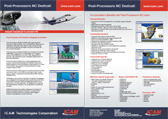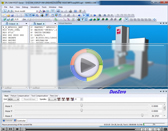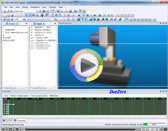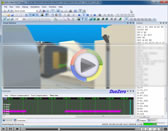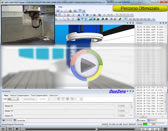Introduction
The Meaning of NC Advanced Post-Processing
It's common thinking that the Post-Processor is a module included in CAM systems, which role is simple translation of the movements of the tool path to the ISO language the CNC. The evolution of CNC machines and numerical controls that equip them, require the use of a very powerful tool integrated with the applications of CAM, and especially at the same technological level of more sophisticated machinery and controls.
Increasingly, the role of the Post-Processor is outlined as that of a new application in the production chain, which can introduce functionality in the toolpath that are not in the DNA of CAM systems, but they are important for the good handle of the machine tool.
DueZero choose the Icam Technologies Cam-Post application to interpret the requests of innovation coming from the market. Over the past decade the continuous collaboration with the machine tools builders and numerical controls builders, plus constant attention to market demands, have led us to identify the main themes on which base the technological innovation in the field of Post-Processing and coined the term Advanced NC Post-Processing.
New Part Programs Layouts
CN Dataserver, Supervisor and Memory
Anyone who has experience with these issues know that the part-program generated by the Post-Processor must have a syntax that does not resemble the classic shopping list sequential typical output of CAM systems. The need to structure the program in main and sub, with syntax rules that allow the flexibility necessary to ensure restarts in the middle of the process, is now almost customary for the latest generation of numerical controls (especially for those of Japanese school), in the use of production of molds or parts with sculptured surfaces where the size of the files in the game is great.
More often the manufacturers equip the machine tools with monitoring systems that require supporting files to the NC programming, with the aim to support additional functionality through pluggable data only in post-processing. The automatic creation of these structures by the post-processor is an element essential to the success of programming.
So
Cam-Post allows you to easily create data structures required, with great advantage in process and with confidence that the creation of individual programs follow precise rules.
Probing Support
The Probing at the service of productivity
Many machine tools users using the recent probing cycles for phases that characterize the tooling of the production, mainly manually. Studies and experience have shown, however, that it may be productive to use the probing and results are more flexible and adaptable to the programming of the machine tool.
The processing of multisided parts from casting is a typical example in which the first difficulty is encountered in determining the best point of origin of the raw part which ensures the complete success of the finished piece. If this, together with the machine tool, does not support the TCP static programming becomes difficult and must be readjust piece by piece.
In these cases the ability to Cam-Post of support probing and produce part-program with kinematic exposed, enables the creation of "intelligent" part-programs, able to dynamically adapt to changes to the origin on angled planes, making possible machining quality even with machine tools not of the latest generation.
Static and Dinamic TCP
Combined support of the two methods
Many kind of CNC are able to support static and dynamic TCP . The real challenge for a post-processing system is to ensure the support in the same time , or within the same post-processors,for the two protocols, and in particular to decide for themselves when they choose to apply either static or dynamic mode.
Cam-Post natively supports, in the core of the product, the individual features of the TCP static and dynamic for the most popular CNC. Over the years DueZero has developed a specific logic that allows the post-processor to create with safety part-program in which the selective application of the static TCP is combined with the dynamic function of the type of the machine tool and to customer preferences. The final result of this strategy is the production of part-programs of high quality, where the movements of the auxiliary machine tool are always governed according to precise rules, drastically decreasing the collision situations and end position of the axes.
Toolpath Optimization
Fitting, Lintol, Look Ahead, Singularity, Rotary Turn Around, C2P and Smart Path
The strength of Cam-Post is definitely the ability to transform and optimize the toolpath from the CAM system, optimizing the customer's specifications and keeping the configuration flexibility through APT commands that can be programmed directly from the CAM system.
Arc Fitting and Spline Fitting can transform toolpaths born in the CAM system as point to point, respectively in strings (for planes or spatial) and arcs more bribes or curves of second order spline or NURBS. Normally the arc fitting is used to drive old generation machine tools or very poor options for high speed CNC. Nurbs option is particularly useful for improving the speed of execution of the tool path, where the path point-to-point does not allow the machine to reach the condition of cut desired.
Lintol allows you to manage linear and angular tolerance, thickening the tool path of intermediate points, in many situations where the linear or angular tolerances are exceeded due to the kinematics of the machine tool. The command is particularly thorough and allows you to manage very complex situations, increasing the quality of workpiece where the CNC machine tool has any gaps. A specific Lintol option, called Cone Pole Singularity, for approximating the tool path when, close to the machine singularity, wide variations occur typically generated by singular axis machined surfaces are not perfectly shaped.
The internal functionality Look Ahead of Cam-Post is used to optimize the movement of multi-axis approach to the work. For example, optimizing the machine position of a double table from the side with greater excursion, allowing to avoid the stroke end during the five-axis movements, or to determinate the best position of the rotary axis in singularity, avoiding successive rotations on the point that could damage the work or tool.
The Rotary Turn Around is used in conjunction with the Path Planning and Look Ahead to optimize the use of rotary axes during multi-axis machining. The Path Planning and Look Ahead can help you determine the best starting position of the rotary axes if possible by providing the most widely used reverse axis. The Rotary Turn Around allows to overcome the physical limits of the stroke of a rotary axis, generating an automatic disconnection of the tool from the part, with consequent rewinding rotary axis and movement of attack at the same point, without any intervention by the CAM operator.
C2P take advantage of the condition of singularity of some machine tools, maximizing the use of the linear axes and minimizing the use of rotary motion. Examples of reference can be traced to the work of mill-turn machines, where the linear axis excursion under the spindle axis is not always possible or is still very low. In this case, when the tool axis is perpendicular to the rotary axis, the polar C2P manages only the movements which would cause up stroke of the linear axes, while the remaining are performed in Cartesian mode. Compared to pure polar mode technology enables significant time savings in processing and is fully automatic.
Finally, Smart Path optimization allow to automatically rebuild all rapid, or high feed, moves linking sinlge manufacturing operations. New moves are generated by Post-Processor and Simulation together avoiding machine end of travel and collision between all simulation components, including dynamic remaining stock.
Special Cycles
Satisfy needs not covered by the CNC or CAM system
Sometimes the special processes require the construction of special machine cycles. Cam-Post can support special cycles operating specific changes to the standards included in the CAM system, or it can support special cycles included in the CAM system when not supported by the CNC. With the use of Cam-Post you can successfully solve any limitations by programming macros that allows you to produce internally or treat a portion of the APT language needed to draw up the correct ISO file or appropriate to the specific limitations of the CNC. This feature can often overcome the limitations that exist between CAM and CNC programming and increasing the chances of allowing a more balanced use of the available resources.





